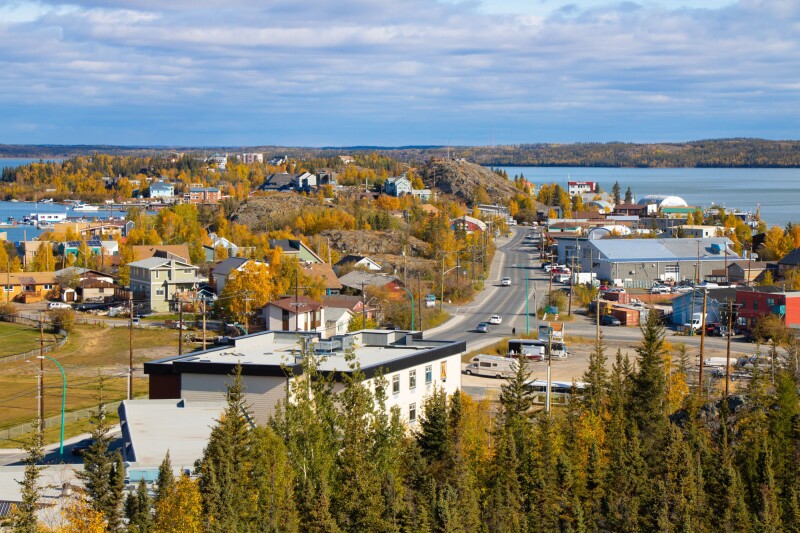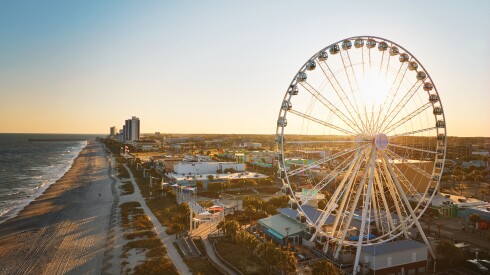This article is part of a series celebrating communities, culture, traditions, and adventure throughout Canada. We’re spotlighting exciting people and places across the country’s provinces, from British Columbia in the west to Newfoundland and Labrador in the east. Read more stories at afar.com/canada.
Old Town Glassworks is not your standard glassworks. Rather, this 31-year-old institution in Yellowknife, Northwest Territories, is a patchwork monument to creativity. Hidden behind a brightly painted shed, a gift shop, and several domes fashioned from old bicycle wheels is a small wooden cabin lined with workshop benches and filled with Anglepoise lamps and assorted knickknacks. It’s a wonderful little temple to tinkering run by Matthew Grogono, a staunch advocate for rethinking, reducing, reusing, and recycling, who repurposes unloved bottles into pieces of art.
The whole setup uses a variety of custom tools. For instance, there’s an old washing machine, controlled with a jerry-rigged treadmill panel, that smooths glass edges. The “guts of a coffee maker,” meanwhile, are used to clean the glass. Every innovation, Grogono explains, is “typical of Northern ingenuity.”
Visitors can get a hands-on introduction to Grogono’s craft by taking one of the two-hour etching workshops he offers to groups of eight or fewer. I participated in one, and my group created keepsakes emblazoned with Canadian iconography: elk, pine trees, and aurora swirls. Grogono, in a sailor’s hat and apron, was an encouraging presence as I worked on several “first drafts” of a stemless wine glass before getting it right.
I’d been drawn to Yellowknife, more than 1,100 miles north of the U.S. border, for the same reason as many travelers: the aurora borealis. The northern lights are visible on as many as 240 nights of the year here, and hotel lobbies fill with groups of people at 9 and 10 p.m. to catch the night sky’s performance. A wide variety of operators put on aurora tours, and many are Indigenous-run. I joined B-Dene Adventures’ Aurora Viewing Tour, during which Bobby Drygeese welcomed us to his cabin for salmon cooked on an open fire and traditional drumming performances, and met Joe Bailey of North Star Adventures, who drives visitors to prime viewing spots and is known as the “Aurora Hunter.” I caught a particularly spectacular display of the lights at the “Cozy Cabin” of Tracy Therrien, the owner and operator of Bucket List Tour.

Due to its northerly location, Yellowknife is sometimes called the Aurora Capital of the World, and it averages about five feet of snowfall per year.
Photo by Zhang JL/Shutterstock (L); photo by Puffin’s Pictures/Shutterstock (R)
As memorable as those experiences were, I came away from my trip just as excited about Yellowknife’s Old Town, an appealing cluster of log cabins, art studios (like the glassworks), fish restaurants, and curiously designed buildings clinging to the shores of Great Slave Lake, North America’s deepest body of water. The provincial capital and its roughly 20,000 residents are defined by the Northern ingenuity and creativity of which Grogono spoke. That’s perhaps not a surprise, given the level of inventiveness required to live somewhere that sees five hours of sunlight a day in December, where the temperature falls as low as -40 degrees (a number so extreme it’s where the Celsius and Fahrenheit scales intersect), and where some regions get more accessible in winter, with the arrival of ice roads.
One of the first places you see the creative spirit is in the architecture around town. The “eraser house,” a diagonally sloping structure that tumbles down a rock face, is one instance of clever land use. The most impressive dwellings, though, are on the water—or the ice, depending on when you visit. Directly offshore, you’ll see the town’s famous houseboats, some 30 floating homes in a variety of shapes and sizes that you can tour on a boat trip with Sundog Adventures. The colorful structures date back to the 1980s, when a couple of enterprising families moved onto the water.
Aboard a Sundog vessel, I zipped out onto the lake in balmy September sunshine, passing a boat flying the Métis flag (an infinity sign, representing the blending of First Nations and European cultures) and another bearing the tongue-in-cheek name Sunk Once. I waved to several owners, and a dog, as my boat glided by the Ingenious abodes, floatplanes buzzing overhead. One of the structures was built around an RV; another boasted a sauna.
Innovation is abundant throughout the larger Yellowknife area, too. You’ll find it at the Buffalo Airways hangar, where “Buffalo” Joe McBryan and his team operate vintage planes that can take off in a foot of snow and deliver supplies to remote communities. (The operation is unique enough to have become the subject of a History Channel reality TV show, Ice Pilots NWT.) I stopped by the hangar as part of Therrien’s daytime Bucket List Tour, and while my group didn’t charter a flight, we walked among the planes, sat in the cockpit of a World War II–era Curtiss C-46 Commando, and bought mementos at the gift shop. (While it was a bit random, my favorite item was a key ring made from a tiny piece of Iron Maiden’s touring plane.)

The city’s rocky, rolling landscape is a by-product of its location on the Canadian Shield, a huge swath of Precambrian rock eroded by glaciers.
Photo by ti1993/Shutterstock
Creativity is a recurring theme at the Prince of Wales Northern Heritage Centre, which has a fascinating exhibition on the mooseskin boats once built by the Shúhta Gotʼı̨nę (Mountain Dene) to carry provisions along the region’s wild rivers. A video from 1982 shows a group making one, which is on display today.
According to the Aurora Hunter, Bailey, who runs an Indigenous storytelling tour during the day and led us around the museum, the boat’s builders used four tools: an axe, a knife, a needle, and their teeth. The job looks awfully tough to me, but not so for them, says Bailey: “We don’t even think about the concept of work. It’s just things that are going to get done. That’s the Dene way. For 50,000 years, we did that.”
Even something as simple as hiking evinces local creativity. On an excursion with My Backyard Tours, I spent a morning clambering over rocky hills and past boulders to reach the 55-foot Cameron Falls, which cascaded under the watchful eye of a bald eagle perched atop a pine. We were the only hikers on the trail (one of the benefits of setting off at 8.30 a.m. in a city full of nocturnal northern-lights seekers), but we weren’t alone. Along the way, we found several inukshuks—small human-shaped figures made of rock piles.
“Inukshuks have always been in this area, since I was a small child,” explained Stacie Arden-Smith, a Tlicho citizen and My Backyard Tours guide. “They’ll be set up in different locations. They change every so often. It’s all dependent on who’s out on the trail, but they’re out here basically to identify that you’re in the right area.”
The rock people act as trail markers, invaluable when the land’s covered in snow. “When you’re up in the barrens, it’s so easy to be turned around,” Arden-Smith says. However, their presence, she notes, is more than just practical: “It’s magical. It’s mystical. Every time you come here, they’re somewhere else”—much like the northern lights, a bucket-list item I was able to cross off, but one that turned out to be merely the start of my magical, mystical tour.











